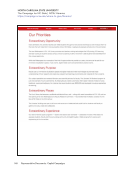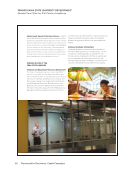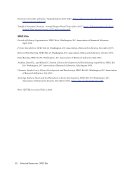6 Survey Results: Executive Summary evaluation factors (21 and 20 responses). A third tier includes number of gift closures, number of asks/ proposals, visits per month or other period, and assisting other units (19, 17, 16, and 14 responses). Other performance measures reported for library directors include creating a culture for strategic fundraising within the library and multi-year or capital campaign outcomes. Compared to the data collected in 2006, this survey suggests some interesting shifts in the measures that are considered important or very important for evaluating library directors. Dollars raised and overall dollar goal are the top two factors in both 2018 and 2006. Number of gift closures and number of asks/proposals were tied for a distant third place in 2006 and dropped to fifth and sixth place in 2018. Number of visits and number of qualified donors increased in importance as evaluation criteria in 2018, but number of moves dropped from fifth place in 2006 to tenth in 2018. Library Coordination with the Institution’s Development Office More than half of the 2018 respondents (31 or 59%) reported that the library is not positioned or supported like other units, schools, or colleges within the institution in terms of fundraising opportunities. In 2006, fewer than half (37 or 47%) reported that was the case. Seven respondents who answered no in 2006 changed their answer to yes in 2018. On the other hand, nine who answered yes in 2006 now say that is no longer the case. Comments from this survey’s respondents indicate other units have assigned development personnel and more development support staff. They also indicated the libraries do not have as many highly rated prospects and suffer from a lack of an alumni base. Only on an occasional basis are most chief LDOs invited to participate in institutional-level meetings about major prospects. Most library directors are only occasionally invited to participate in institutional-level strategy meetings on fundraising. Both of these findings are comparable to levels reported in 2006. The vast majority of respondents indicated the library was at least occasionally, if not always, included in institutional direct mail campaigns and phone-a-thons. Almost all of the respondents indicated the library was included in the institution-level fundraising website as a possible gift designation. Library development staff and personnel from the institution’s central development operations are engaged in numerous development-related activities. Most often, the library provides more significant funding level and staffing effort for special events, major gifts, and development communications. Central unit effort and funding is most often more significant for activities surrounding annual giving, direct mail, corporation and foundation relations, deferred or planned giving, information technology, gift processing, prospect research, records processing, and conducting phone-a-thons. Boards, Friends, and Alumni Association Support Development is a team sport. It’s not just the director of development and his or her staff, but the university librarian, and often the director of communications and subject specialists, who influence donors toward making a gift to the library. For the most mature library development programs, it’s also often major gifts generalists and planned gift officers, and senior university administrators, including the president or chancellor, who help influence donors to support the library. But it is also student and alumni groups, Friends of the Library, and boards that ensure the long-term health of the library through financial support and advocacy. Twenty-nine of 51 respondents (57%) reported having a library development board. Of those, 27 (93%) said that board members were expected to support the library financially and 24 (83%) through advocacy. Twenty-two respondents (43%) said they had a library friends group, with 19 of them (86%) expected to support the library financially and 11 (50%) to support it through advocacy. Forty respondents (67%) reported that their institution had an alumni association, but only two (5%)



















































































































































































